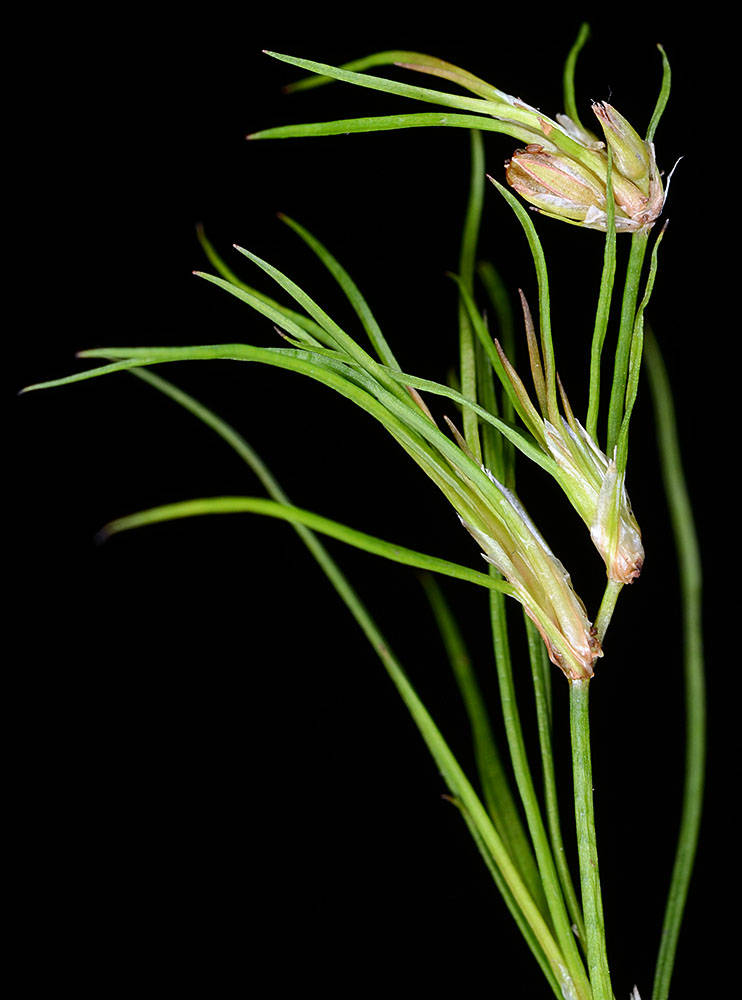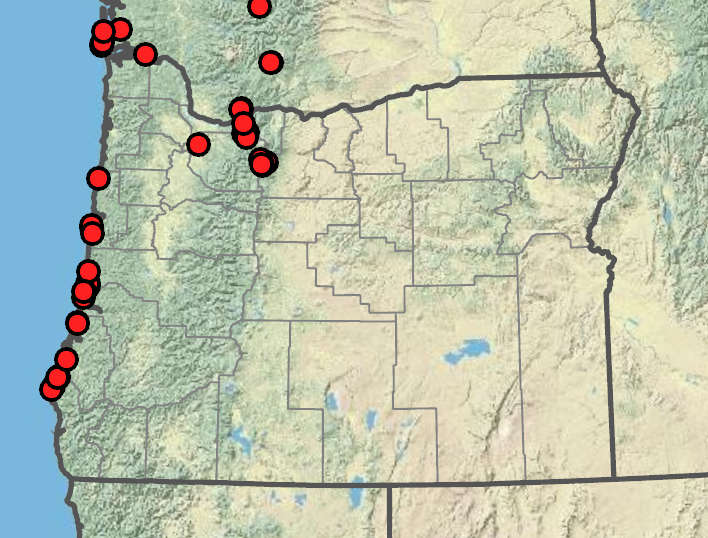Juncus tenuis
Juncus supiniformis
path rush, poverty rush, slender rush
hair-leaved rush, spreading rush
thin and wiry;
blade flat and slightly inrolled, usually 1–8 mm on early season shoots; dirty white or translucent, scarious; acute or acuminate;
auricles soft and thin.
numerous; capillary, 0.2– 0.3 mm wide if aquatic; round; hollow, septate;
auricles 0.8–2.1 mm.
cymes, usually small, 1–6 cm; individual flowers often longer than internodes;
bractlets subtending flowers usually acute (blunt).
open, cymes of 2–9 clusters; clusters 2–5(12)-flowered, often bearing leafy bulblets.
tepals 6, 3–4.1 mm, green to reddish;
tips acuminate;
stamens 6;
filaments 0.6–1.2 mm;
anthers usually 0.4–0.6(0.8)mm;
styles 0.1–0.3(0.5)mm.
tepals 6, 3.4–5.4 mm, brown; greenish or reddish;
inner tepal margins usually inrolled;
tips acuminate;
stamens 3 or 6;
filaments 0.8–1.5 mm;
anthers 0.5–0.8 mm;
styles 0.1–0.4 mm.
usually 2.5–3 mm; more than 75% the length of; and shorter than the tepals, pale brown;
apex usually blunt (acute), not crested, 1-chambered.
usually 1–1.5 mm longer than the tepals, brown to dark brown; without metallic gloss, 1-chambered.
0.4–0.5 × 0.2–0.25 mm, apiculate.
ellipsoid to ovoid, 0.6–1 × 0.2–0.3 mm, apiculate, striate.
=40, 80.
Juncus tenuis
Juncus supiniformis
Shores, swales, springs, dune hollows, wet woods, marshes, damp paths, ditches, cranberry farms, moist disturbed sites. 0–1800m. BW, Casc, CR, Est, Lava, Sisk, WV. CA, NV, ID, WA; throughout most of North America. Native.
Juncus tenuis is usually much smaller than Juncus anthelatus. The blunt unridged capsules separate J. tenuis from J. confusus, J. occidentalis, and J. trilocularis.
Shores, peatlands, marshes, wet dune hollows, often in shallow water. 0–1100 m. Est, Casc. CA, WA, north to AK. Native.
Like introduced Juncus bulbosus, this species can bear bulblets in the inflorescence, and both are variable in habit depending on water levels. They differ in the shape of the tepal tips and length of the capsules. Juncus articulatus is similar but has blunter tepal tips and is common on disturbed wet ground.
Peter Zika
Peter Zika
- Local floras:
BC,
CA,
OR,
WA
- Local Web sites:
CalFlora,
CalPhotos,
Flora NW,
PNW Herbaria
WildflowerSearch
iNaturalist (observations)
USDA Plants Database
- LBJ Wildflower Center
- SEINet
- Plants of the World Online
- Encyclopedia of Life
- Wikipedia
- Google Image Search
- Local floras:
BC,
CA,
OR,
WA
- Local Web sites:
CalFlora,
CalPhotos,
Flora NW,
PNW Herbaria
WildflowerSearch
iNaturalist (observations)
USDA Plants Database
- LBJ Wildflower Center
- SEINet
- Plants of the World Online
- Encyclopedia of Life
- Wikipedia
- Google Image Search



